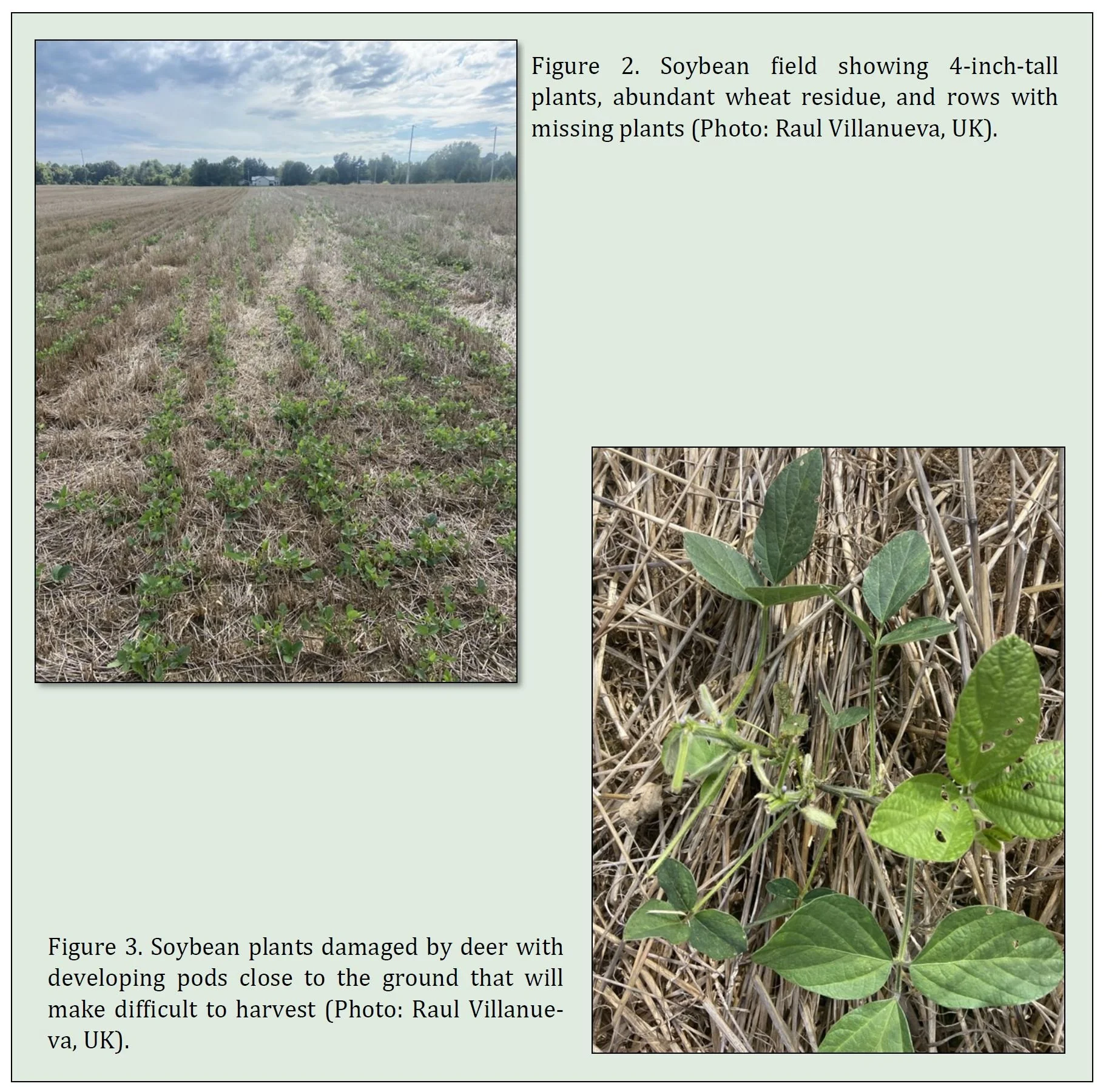A Combination of Environmental Factors, Living Organism, and Lack of Scouting can Bring Disaster to Soybeans
On Thursday (9/1/22), I received a series of pictures showing a soybean field with small plants (shorter than the wheat residue), blank patches, soybean plants with severed stems by apparently feeding by deer, and stripped blister beetles feeding on the leaves (Figure 1). This was an initial observation based on the images. Then, I decided to visit this field the following day.
On Friday (9/2/22), I visited, walked, and inspected this 68-acre commercial, double-crop soybean field. The soybean plants were in very bad shape:
most of the soybean plants were on the R6, less than 4 ft tall (~10 cm), and rows with many skips, (Figures 2 and 3),
most plants with stems cut by deer (stems cut with ragged appearance compared 45 degrees clean cuts made by rabbits) (Figure 3),
abundant wheat stand residues with areas that have more than two-inch height straw “cushion” (Figures 1, 2, and 3),
slugs found under this cushion of wheat residue (Figure 4)
many vole mounds,
foliage with holes caused by bean leaf beetles (Figure 3), and
a good number of yellow stripped blister beetles.
What caused all these problems? Solutions ….?
In this case, the identification of a single issue that caused such devastation in this field was not possible. However, there are some issues that combined might have caused such type of injuries or disastrous damages to this field.
Environmental conditions: The absence of rains in Western Kentucky may have contributed to the size of the plants, rains were scarce in June and July causing delays on emergence, low seed emergence, and slow plant growth. Also, rains contributed to low production of forages or grasses that may have reduced the impact of deer feeding in soybeans.
Slugs: Wheat residue on this field may have contributed to the presence of slugs, although the farmer or the company that takes care of this field did not report any damages by mollusks; the presence of rains by the end of July and beginning of August may be contributed with a non-reported outbreak of slugs. We found between 3 to 6 slugs per sq/ft (Figure 4) while searching for slugs under wheat residues. The ground under the residue was moist and temperatures were probably 10 to 15 degrees lower than the air temperature (these temperatures are based on unpublished studies conducted by my group under similar circumstances in 2022). Under these conditions, slugs may have fed on soybeans plants at night whereas during the day they were well protected under the wheat residue escaping from tallies conducted by scout agents.
Rodents: Many rodent species such rabbits, groundhogs and voles may feed on soybeans, but here, voles had partial responsibility on plants skips. We found several mounds in this field. In addition, voles were reported in this same region (Christian County) causing severe damage to soybean fields (Figure 5).
Insects: We observed several bean leaf beetles and a little higher number of stripped blister beetles during the time we stay in this field. Blister beetles feed on the foliage but in addition larvae of these insects are predators of grasshopper eggs. However, foliage was not heavily damage by feeding of any of these insects. The impact of insects on the state of this field may be minimal to none.
Final thoughts
Although there is a chance that plants may grow, the pods and flowers in these plants are near the soil (Figure 3), and number of pods per plant are low; as a consequence, combines won’t be able to harvest this field.
For the management of voles there is no products that are currently registered in Kentucky. Disking or some minimal tillage may be an option to reduce or disrupt nests.
Cover crop is important for soil conservation, prevents soil erosion and protects water quality, keep soils moist, reduces soil compaction with fewer trips and less tillage, saves fuel, labor, and time with reduced field operations, and sequesters carbon in the soil. However, for full season or double crop soybeans, residue management from previous crop is critical. Mollusks (snails and slugs) were observed causing severe injuries to several soybean fields, even when environmental conditions were not feasible for their development (see Snail Outbreak during the Drought and Hot Conditions Affect Soybeans). Mollusk found very good environmental conditions under residues from the previous crop (corn, wheat, or cover crops), these conditions are conducive to cause outbreaks that affect soybean fields if residues are not properly managed.
All the combination of issues described above may have contributed to the bad conditions observed in this field. Thus, the yield from this field may be entirely lost, in this particular case if we calculate the entire loss of yield at 55 Bu/A, and $15.49/Bu (price of 9/12/22) of the 68 acre-field, the total amount to be lost will be around $58,000.
More information
Conducive Weather for Seedcorn Maggot & Slugs Outbreaks in Field Crops. Kentucky Pest News University of Kentucky
Striped Blister Beetles Defoliate Tomatoes & Potatoes. Kentucky Pest News University of Kentucky
Blister Beetles Predatory Behavior Outweigh Their Feeding in Soybeans in Kentucky. Kentucky Pest News University of Kentucky




